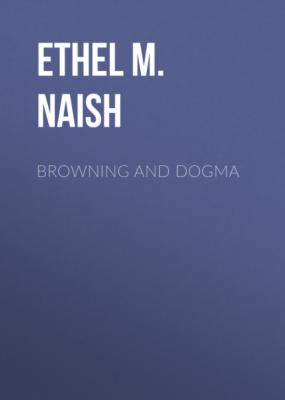ТОП просматриваемых книг сайта:
Browning and Dogma. Ethel M. Naish
Читать онлайн.Название Browning and Dogma
Год выпуска 0
isbn 4064066127787
Автор произведения Ethel M. Naish
Жанр Документальная литература
Издательство Bookwire
Ethel M. Naish
Browning and Dogma
Seven Lectures on Browning's Attitude Towards Dogmatic Religion
Published by Good Press, 2021
EAN 4064066127787
Table of Contents
LECTURE I INTRODUCTORY, AND CALIBAN UPON SETEBOS
LECTURE III BISHOP BLOUGRAM’S APOLOGY
LECTURE IV CHRISTMAS EVE AND EASTER DAY (i)
LECTURE V CHRISTMAS EVE AND EASTER DAY (ii)
LECTURE VI CHRISTMAS EVE AND EASTER DAY (iii)
SYNOPSIS
| LECTURE I | ||
| Sources of Browning’s influence as a teacher. | ||
| Connection between the five poems of the Course. | ||
| Caliban upon Setebos—Origin of—Criticisms. | ||
| Characteristics of Caliban. Cf. Caliban of Shakespeare. | ||
| Analysis of Poem. | ||
| (i) | Introductory (ll. 1-23). | |
| (ii) | Conception of Setebos. | |
| (a) | Place of abode (ll. 24-25). | |
| (b) | Creator of things animate and inanimate (ll. 26-55). | |
| (c) | Motives of Creation: self-gratification or wantonness (ll. 55-84, 170-199). | |
| (d) | Answer to prayers addressed by his creatures uncertain because result of caprice (ll. 85-97). | |
| (e) | Main characteristic—Power, irresponsible and capricious (ll. 98-126, 200-240). | |
| (iii) | “The Quiet” and Caliban’s estimate of evil (ll. 127-141, 246-249). | |
| Other lines of thought relating to: | ||
| A. | Doctrine of Sacrifice. | |
| B. | A Future Life. | |
| C. | Indirect suggestion of necessity of an Incarnation of the Deity arising from negative conditions ascribed to “the Quiet.” | |
| LECTURE II | ||
| CLEON | ||
| Cleon. Cf. Caliban: (i) Dramatic change; (ii) point of contact. | ||
| Greek conception of life—Influences affecting Cleon. | ||
| Analysis of Poem. | ||
| I. | Introductory and descriptive (ll. 1-42). | |
| II. | Varied attainments of Cleon indicative of progress of race through development of complexity of nature (ll. 43-157). Includes (ll. 115-126) Cleon’s conception of an Incarnation. | |
| III. | Answer to question of Protus, Is death the end to the man of thought as well as to the man of action? (ll. 158-323.) | |
| Increase of happiness not necessarily accompaniment of fuller knowledge (ll. 181-272). | ||
| Fuller insight, attribute of artist-nature, rather productive of keener sense of loss in face of death (ll. 273-323). Cf. Old Pictures in Florence, etc. | ||
| IV. | Hence arises conception of necessity to man of future life (ll. 323-335.) | |
| V. | Conclusion. With reference to current reports of Christianity. Cf. Cleon and Paul (ll. 336-353). | |
| LECTURE III | ||
| BISHOP BLOUGRAM’S APOLOGY | ||
| Dramatic character of poem. | ||
| Connection with preceding poems. | ||
| Identity of Bishop Blougram—Browning’s treatment of subject—Criticisms discussed. | ||
| Indications of identity—A. External. B. Personal characteristics. | ||
| Analysis of Poem. | ||
| I. | Epilogue (ll. 971-1014). How far is the Bishop serious in his assertions? | |
| II. |
Introductory. Bishop and Critic (ll.
| |

